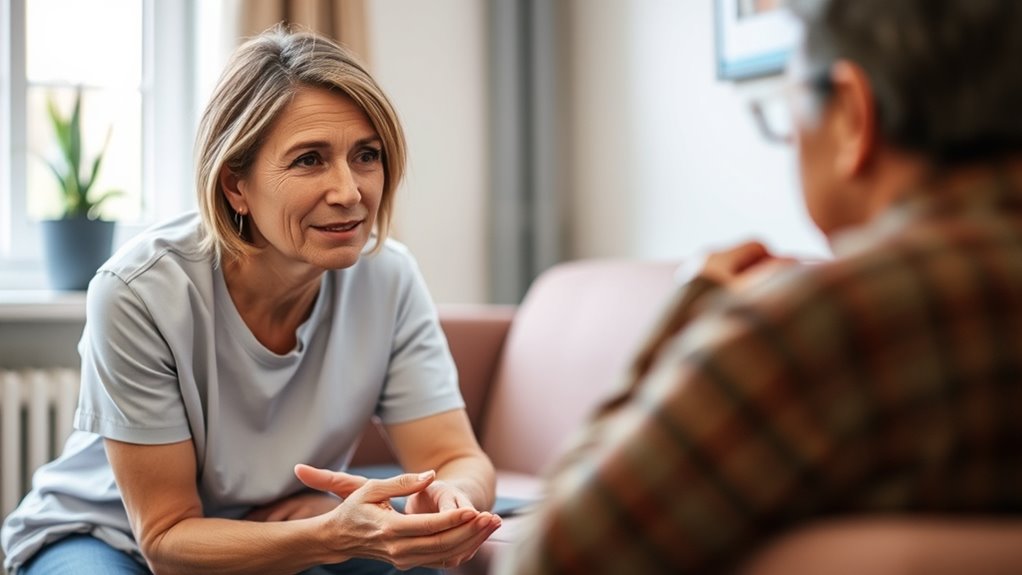To develop effective active listening skills as a caregiver, focus on giving your full attention, using eye contact, and observing nonverbal cues like facial expressions and gestures. Show empathy by understanding their perspective and offer verbal affirmations such as “I see” or “That sounds challenging.” Practice patience, stay present, and mirror nonverbal signals to build trust. If you keep exploring, you’ll discover even more ways to strengthen your connection and support those you care for.
Key Takeaways
- Focus fully on the speaker, minimizing distractions to demonstrate attentiveness.
- Use verbal affirmations and reflective statements to validate and clarify understanding.
- Observe and interpret nonverbal cues like facial expressions and gestures for deeper insight.
- Maintain eye contact and open body language to foster trust and comfort.
- Practice patience and empathy, ensuring a nonjudgmental attitude to encourage open communication.

Have you ever wondered why some conversations feel more meaningful than others? It’s often because of the connection you feel with the other person, which is largely influenced by your ability to listen actively. As a caregiver, honing your active listening skills isn’t just about hearing words; it’s about truly understanding and engaging with what the person in front of you is communicating. One essential aspect of this is empathy development—your capacity to put yourself in their shoes and see the world from their perspective. When you listen with empathy, you create a safe space where they feel valued and understood, which can greatly improve your relationship and their comfort level.
Nonverbal cues play a key role in this process. These are the subtle signals you unconsciously send and interpret—like facial expressions, gestures, eye contact, and posture—that often convey more than words ever could. Being aware of your own nonverbal cues helps you show attentiveness and openness, reassuring the speaker that you’re fully present. At the same time, paying close attention to theirs can reveal emotions or concerns they might not express verbally. For example, a slight frown, tense shoulders, or avoiding eye contact can indicate discomfort or hesitation, prompting you to approach the conversation with extra sensitivity. Recognizing these cues allows you to respond more compassionately, demonstrating that you genuinely care about what they’re sharing. Developing awareness of nonverbal communication can significantly enhance your understanding and connection during interactions.
Developing empathy through active listening is a skill that takes practice. It requires you to be patient, present, and nonjudgmental, setting aside distractions or preconceived notions. When someone is speaking, focus on their words but also on how they say them—the tone, pace, and volume—all of which can provide deeper insight. Confirm your understanding through verbal affirmations like “I see” or “That sounds challenging,” and mirror their nonverbal cues subtly to build rapport. This not only encourages them to open up more but also strengthens trust between you.
Frequently Asked Questions
How Can I Improve My Active Listening Skills Quickly?
To improve your active listening skills quickly, focus on developing empathy by genuinely understanding the speaker’s feelings. Pay close attention to non-verbal cues like facial expressions and body language, which reveal unspoken emotions. Practice summarizing what you hear to show you’re engaged and clarify understanding. By consciously observing these cues and responding empathetically, you’ll deepen connections and become a more effective listener in no time.
What Are Common Barriers to Active Listening in Caregiving?
You might face barriers like difficulty developing empathy or missing nonverbal cues, which can hinder your active listening. Distractions, personal stress, or assumptions also block your ability to fully understand others. To overcome these, focus on improving empathy development and pay close attention to nonverbal cues. Stay present, minimize distractions, and remind yourself to listen actively, creating a supportive environment that encourages open communication.
How Do I Handle Emotional Reactions During Active Listening?
When emotional reactions flare, think of yourself as a steady lighthouse amid stormy seas. To handle this, practice emotional regulation by taking deep breaths and maintaining a calm tone. Show empathetic responses by validating feelings without judgment, letting the person know you’re present and understanding. This helps diffuse tension, allowing you to stay focused and supportive, turning emotional reactions into opportunities for deeper connection.
Can Active Listening Help Prevent Caregiver Burnout?
Yes, active listening can help prevent caregiver burnout by enhancing empathy development and strengthening communication strategies. When you truly listen, you connect more deeply with those you care for, reducing misunderstandings and frustration. This process also provides emotional relief, as you feel heard and supported. By practicing active listening regularly, you build resilience, foster positive relationships, and maintain your own well-being, making caregiving more sustainable and less exhausting.
What Tools or Techniques Support Effective Active Listening?
Want to master the art of active listening? Start with reflective prompts like “Tell me more,” and watch your conversations deepen. Don’t forget non-verbal cues—nodding, eye contact, and open posture—that silently scream “I’m all ears!” These tools make your listening skills shine, ensuring you truly understand and connect, rather than just wait for your turn to talk. Because, really, who doesn’t want a conversation that actually gets somewhere?
Conclusion
By honing your active listening skills, you build trust and understanding with those you care for. For example, imagine a caregiver noticing a resident’s subtle sighs and gently asking, “Are you feeling okay?” This simple act shows you’re truly present. When you listen attentively, you foster stronger connections and make your loved ones feel valued. Keep practicing active listening, and you’ll create a more compassionate, supportive environment for everyone involved.









